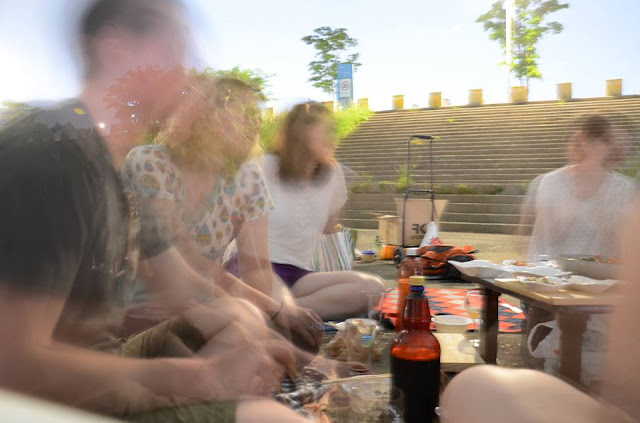OUR TRAINING
We were raised cooking for large crews of people in small/portable kitchens. For example, mom baked this birthday cake in the portable oven that sat over a gas range. (You can see it behind her head on the right.) This is how we learned to make homemade ovens for gas ranges like THIS ONE we made here in Korea a few Christmas ago when we really wanted cookies.
You will also notice that the table and cooking counter are made from found and reclaimed arctic timbers. They were raw, rugged and the most beautiful thing I've ever seen. Kitchens don't have to be fancy and new to be loved and useful. In this kitchen we cooked three meals a day for up to twenty people. We baked bread, cakes, pies and anything else we could imagine. There were never excuses, there was just getting delicious things done.
In addition, all of our water was hauled from a nearby river and boiled for dishes and cooking, we sunk barrels into the ground where we kept items that need refrigerated and the nearest shop was a 500 mile flight away.
With all of these complications, we had to be very creative. We often ran out of important ingredients before new shipments could arrive. We had to find ways of making up for their absence in a way no one would notice. Which is how mom became the master of substitutions. She taught us how to do the same. Sometimes we would place all of our ingredients on the counter and brainstorm for ages, trying to imagine the food we had left could still make something. In the end, it always worked. We always found a way.
This is the sort of fun we love to have in our adopted international homes and the inspiration behind our fusion recipes. Our weird childhood was the perfect training for a happy and delicious expat life.
You will also notice that the table and cooking counter are made from found and reclaimed arctic timbers. They were raw, rugged and the most beautiful thing I've ever seen. Kitchens don't have to be fancy and new to be loved and useful. In this kitchen we cooked three meals a day for up to twenty people. We baked bread, cakes, pies and anything else we could imagine. There were never excuses, there was just getting delicious things done.
In addition, all of our water was hauled from a nearby river and boiled for dishes and cooking, we sunk barrels into the ground where we kept items that need refrigerated and the nearest shop was a 500 mile flight away.
With all of these complications, we had to be very creative. We often ran out of important ingredients before new shipments could arrive. We had to find ways of making up for their absence in a way no one would notice. Which is how mom became the master of substitutions. She taught us how to do the same. Sometimes we would place all of our ingredients on the counter and brainstorm for ages, trying to imagine the food we had left could still make something. In the end, it always worked. We always found a way.
This is the sort of fun we love to have in our adopted international homes and the inspiration behind our fusion recipes. Our weird childhood was the perfect training for a happy and delicious expat life.






















































